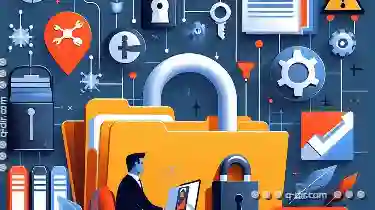One such concept is the folder-a virtual container used to organize files on a computer system. As we look ahead, two predominant predictions emerge ...
 regarding folders: they either become extinct or undergo a significant reinvention. This blog post will explore these possibilities and discuss how current trends might shape their future usage in computing environments. In the rapidly evolving landscape of technology, it's fascinating to consider how concepts we take for granted today might transform by the year 2030.
regarding folders: they either become extinct or undergo a significant reinvention. This blog post will explore these possibilities and discuss how current trends might shape their future usage in computing environments. In the rapidly evolving landscape of technology, it's fascinating to consider how concepts we take for granted today might transform by the year 2030.1. The Decline of Physical Media
2. Artificial Intelligence and Machine Learning
3. Augmented Reality and Virtual Spaces
4. Blockchain for Data Security and Decentralization
5. Evolution into More Dynamic Structures
6. Shift from File Management to Content Management Platforms
7. The Rise of Nano-Folders
8. Conclusion: Reinventing Beyond Physicality
1.) The Decline of Physical Media
In the past decade, there has been a noticeable shift from physical to digital media storage. Cloud services like Google Drive, Dropbox, and iCloud have made it easier than ever to store vast amounts of data remotely without needing physical devices. This trend is expected to continue and possibly accelerate by 2030. As more people rely on cloud-based storage solutions for their personal and professional files, the need for local folders might diminish as they can be accessed from anywhere with an internet connection.
2.) Artificial Intelligence and Machine Learning
Advancements in AI and machine learning could lead to intelligent systems that automatically categorize and organize files based on content and context. Rather than users manually creating folders, algorithms might dynamically sort data into relevant groups without the need for human intervention. This would simplify file management but also reduce user control over where their files are stored or accessed from.
3.) Augmented Reality and Virtual Spaces
Augmented reality (AR) and virtual reality (VR) technologies could offer new ways to visualize and interact with digital folders in immersive environments. For example, AR glasses might overlay visual representations of folder structures directly into the user’s field of view, making navigation intuitive and efficient without physical interfaces. This reinvention would redefine how we interface with our digital assets.
4.) Blockchain for Data Security and Decentralization
The blockchain technology is known for its decentralized nature which offers enhanced security through multiple layers of encryption. By 2030, it’s possible that folders could be implemented on a blockchain network where each block represents a version of the file history, ensuring tamper-proof storage without the need for central authorities like cloud providers. This would decentralize control and potentially reduce privacy concerns associated with centralized data storage.
5.) Evolution into More Dynamic Structures
Instead of static folders, by 2030, we might see a shift towards more dynamic structures such as "smart folders" or "contextual folders." These could dynamically adjust based on user behavior, content analysis (like file type and frequency of use), real-time network conditions, or even emotional states. This adaptability would make folder management much more personalized and efficient than static configurations can offer.
6.) Shift from File Management to Content Management Platforms
By the time we reach 2030, content platforms might supersede traditional folders as they integrate multiple types of media (text, audio, video, etc.) in a single platform. These platforms would provide enhanced search capabilities and intuitive interfaces for managing all digital assets under one umbrella, making it easier to navigate through large collections without the need for separate folder structures.
7.) The Rise of Nano-Folders
With miniaturization technologies on the horizon, future devices might enable nano-folders that are virtually indistinguishable from nanoscale objects. These could be embedded within surfaces or clothing, automatically syncing and organizing files based on their size, shape, and material properties. This reinvention would redefine physical and virtual boundaries between data and reality.
8.) Conclusion: Reinventing Beyond Physicality
While the idea of folders disappearing entirely is speculative, more likely scenarios involve them evolving into forms that are less tangible and more integrated with our digital lifestyles. The future could see a shift towards AI-driven management, blockchain security, or even into the realm of AR/VR interfaces where the concept of physical storage itself becomes obsolete in favor of dynamic, personalized solutions.
As we move forward, it's essential to stay adaptable and open to new technologies that might redefine how we organize and access information. Whether folders persist as a familiar interface or transform beyond recognition, their legacy will be one of innovation and adaptation within the ever-changing digital landscape.

The Autor: / 0 2025-04-08
Read also!
Page-

Columns View: For Uninterrupted Categorization
Among the myriad tools available to manage and analyze data, **Columns View** emerges as a powerful paradigm that enhances how we categorize ...read more

Folder Permissions: Controlling Access
Welcome to this comprehensive guide on folder permissions, where we'll delve into the essential concepts of managing access control for folders. ...read more

Cutting Edge or Cutting Corners: The Ambiguity of "Cut.
This seemingly straightforward action can lead to misunderstandings about how data is handled on your computer. Understanding what “cut” truly ...read more